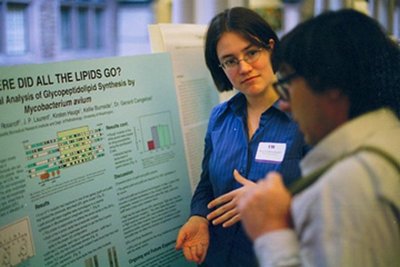May 18, 2006
Students strut their stuff at Undergraduate Research Symposium
Helping paraplegics to walk upright and enabling the blind to “see” computer graphics. Studying why birds sing and how Magellanic penguins survive their youth. These are state-of-the-art faculty research projects, no?
No indeed. All designed and carried out by undergraduates here at the UW.
These and a host of other scholarly inquiries will be explained in detail from noon to 5 p.m. on Friday, May 19, at the Ninth Annual UW Undergraduate Research Symposium, to be held in the expansive commons of Mary Gates Hall.
There, more than 500 undergraduate students from the UW, Seattle University, Western Washington University and North Seattle Community College will show off their research skills and successes in a lively afternoon that’s open to all. It’s a chance for them to share the work they’ve been doing with a larger audience of friends, family and campus colleagues.
The research projects that make up the symposium range from the frontiers of science to nanotechnology, immigration, questions of public expression, environmental conservation, historic preservation and more.
The symposium, and the hard work behind it, reflect a level of skill and professionalism that some don’t at first connect with undergraduate studies, said Janice DeCosmo, UW assistant dean for undergraduate education. But that’s where they’d be wrong.
“One of the most surprising things to people when they come to the symposium is that the students are doing real research. These are real problems, questions of importance they are examining and pursuing,” DeCosmo said. “Not just something that is a minor detail in support of someone else’s work, or a made-up homework assignment.”
This seems to come clear, too, in the topics being pursued by some of the students.
- Eros, Logos and Wikipedia: Postmodern Knowledge & Lytard’s Paralogy will discuss the growing trend of open-source reference works, and how a base of knowledge is created by many, no longer just a select few.
- Semi-Autonomous Powered Reciprocating Gait Orthosis, AKA Robot Suit presents the possibility of a lightweight device to hold paraplegic patients upright and enable them to walk (also known as They Shall Walk.)
- Annotating Braille Text Label Placement in Scientific Programs, part of the ongoing Tactile Graphics Project, seeks to enable people with impaired sight to interact with graphics and images in scientific texts by presenting information in a tactile format.
- The Conservation of the Gettysburg Cyclorama recognizes the importance of the cyclorama to 19th century America and discusses ways to repair and protect Paul Philippoteaux’s 1883 cyclorama The Battle of Gettysburg, one of the last surviving examples of the art form.
- Conservation Management Schemes: What’s Good for the Gander Isn’t Always Good for the Gooseberry will review the history of the Northwest Trek Wildlife Park and why much of the area has become degraded in the 25 years since its inception.
DeCosmo said the undergraduate research projects also can change the age-old ways in which students and faculty interact. For students, she said, “the work takes on an importance, to themselves and to professors, that it might not have had before … they begin to interact on a different level with professors and graduate students, and become part of an academic conversation.”
And faculty members, she said, have their interest heightened by the projects. “When there is a topic so stimulating to both the student and the professor, the professors engage the students in a different way, and it’s exciting and productive for both of them.”
She added, “Professors want nothing more than to have students who are excited about their work. When they find students that are also really motivated, they just soar.”
The Ninth Annual UW Undergraduate Research Symposium will begin with a welcome at noon from Provost Phyllis Wise. For more information about the event, visit online at www.washington.edu/research/urp/symp/.



